How to Make Homemade Garlic Powder
This post may contain affiliate links, which means that I may receive a commission if you make a purchase using these links. As an Amazon Associate I earn from qualifying purchases.
Make your own homemade garlic powder by dehydrating and grinding garlic cloves. Using garlic powder in your cooking is a quick way to add lots of flavor to a dish. Learn how to make homemade garlic powder and garlic flakes with this easy tutorial.
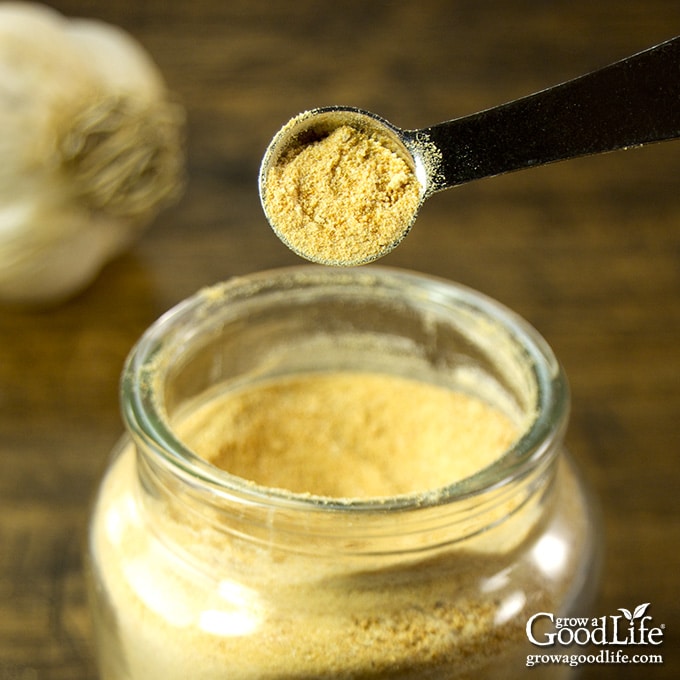
When properly cured, garlic can last a while when kept in a dark, and cool location. However, sometimes finding the perfect storage environment isn’t possible. Thankfully, another great way to preserve garlic is to dehydrate it.
Benefits of Preserving Garlic Powder
Having garlic powder in your kitchen spice cabinet can be very useful. Here are some reasons you may find yourself reaching for the garlic powder instead of fresh garlic:
- It is a shelf-stable pantry staple: Dehydrating garlic increases the shelf life of your homegrown garlic. Once dried, garlic powder can last a long time in your pantry or spice cabinet. Garlic powder is a good alternative to have on hand as a backup for times when you are out of fresh garlic.
- A great shortcut for the time crunched: There are times when we are in a rush to get a meal together. When taking the time to peel and chop garlic is going to make dinner late, substituting garlic powder is a quick way to add lots of flavor to a dish. The flavor of garlic powder is more concentrated than fresh garlic.
- Perfect for dry seasoning mixes: Garlic powder works well in make ahead DIY herb blends, seasoning mixes (such as this Homemade Taco Seasoning), and dry rubs. It combines easily with the other dried herbs and spices to make a shelf-stable mix.
- Ideal for flavoring ground meats: Chunks of chopped garlic will not soften in ground meats that are cooked briefly, such as meatballs, burgers, and sausage. Instead, use garlic powder to disperse flavor throughout the ground meat mixture.
- Dissolves in any liquid: Powdered garlic dissolves and infuses when incorporated with liquids, making it an ideal flavoring for marinades, salad dressings, and brines.
- Adds flavoring as a condiment: Garlic powder can also be sprinkled on almost anything from pizza to popcorn to soups, meats, vegetables, or any edible that may be improved with extra garlic flavor.
Tips for Dehydrating Garlic
If you grow garlic or purchase in bulk and still have an abundance in storage come spring, it may be worth the effort to turn the excess into garlic powder before the cloves go bad. Here are tips to help you turn fresh garlic into dried garlic flakes and garlic powder:
Use a Food Dehydrator
A food dehydrator is a valuable kitchen tool for preserving the harvest. It works by flowing warm air through drying screens. For small batch dehydrating, this stackable food dehydrator will serve you well. For larger-scale food dehydrating, consider one of the Excalibur dehydrators.
Other Ways to Dry Garlic
If you don’t have a food dehydrator, you can dry garlic slices by layering on drying screens in a warm room or passing a threading needle through the slices and hanging to air-dry. Be sure the slices have spaces in between so they dry evenly. You can also use your oven to dry garlic using one of the lowest heat settings. For most ovens, this is between 150-200˚F (67-93˚C).
Slice the Garlic Evenly
Try to slice your garlic cloves in uniform pieces, so they will dry at the same rate. If your garlic slices are different thickness, check the dehydrator several times during the drying process, and remove the pieces that are finished before the others.
If you are dehydrating a lot of garlic regularly, it may be worth it to invest in a garlic slicer. This dual purpose garlic press tool both slices and minces garlic. It will even slice garlic with the skins on.
Dry Using Low Heat
Dry slowly and at low heat. You may be tempted to turn up the heat to speed things up, but you run the risk of bitter garlic. If the garlic gets brown during drying, it will be bitter. The goal is to let it dry gently, while still retaining the flavor and aroma.
Dehydrate in a Well Ventilated Area
The smell of garlic will infiltrate your home. If you can, locate your dehydrator in an area that is very well ventilated, such as a screened in porch.
Take Your Time
Dehydrate your garlic can take up to 12 hours, depending on the humidity level in the air and how thinly you sliced your garlic. It is ok to turn the dehydrator off at night partway through and start it up again the following day. Dehydrate until the garlic snaps when you bend it.
How to Prevent Garlic Powder from Clumping
Add a teaspoon of uncooked grains of rice to the container of garlic powder. The rice will absorb excess moisture and help prevent the garlic from clumping. Remove rice before using garlic powder.
Steps for Making Homemade Garlic Powder
Make your own garlic powder by dehydrating and grinding garlic cloves. If you grow garlic or purchase in bulk and still have an abundance in storage come spring, it may be worth the effort to turn the excess into garlic powder before the cloves go bad.
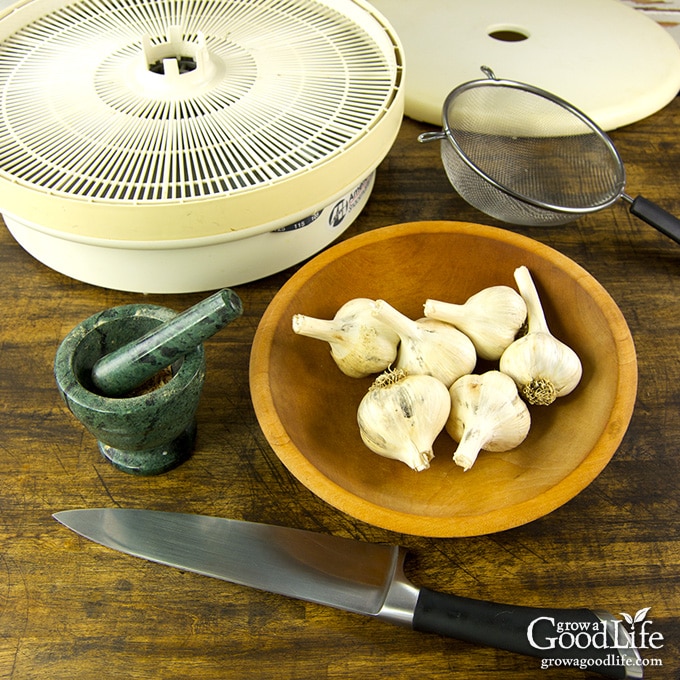
Step 1: Separate the Cloves
Remove the cloves from the head of garlic. Peel off the papery skins, and slice the cloves thin.
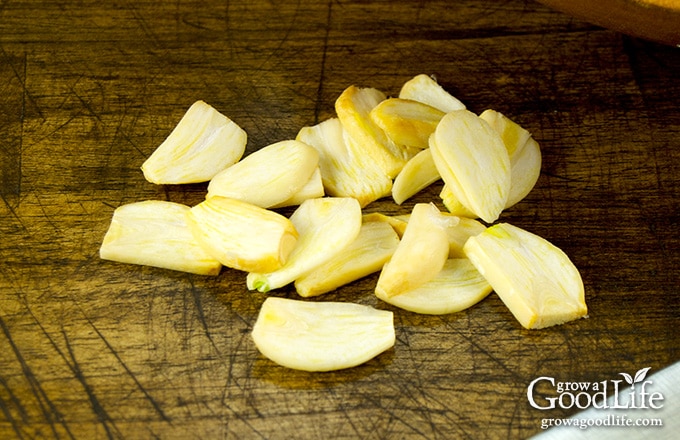
Step 2: Place Slices on Dryer Screens
Lay the garlic slices on the dehydrator screens, and dehydrate at a low temperature until the garlic is dry.
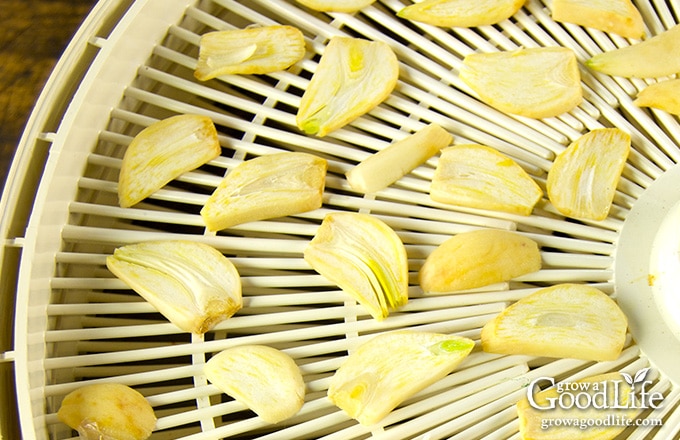
Step 3: Grind the Dry Garlic into Powder
Use a mortar and pestle, high quality blender, spice grinder, or coffee grinder to grind the dehydrated garlic. Then sift the ground garlic powder through a strainer to separate the garlic powder from garlic flakes. The larger pieces are ideal for using in soups and stews where they will rehydrate, soften, and add plenty of flavor.
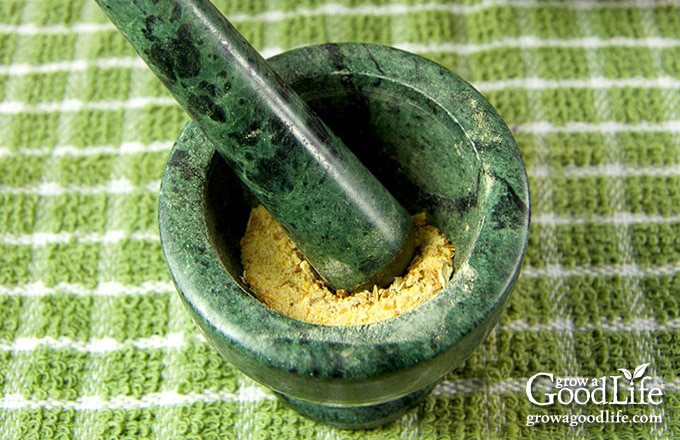
Step 4: Store in an Airtight Container
Store your garlic powder in a glass container with an airtight lid in a dark, cool location. I fill a small jar with garlic powder for my spice cabinet, and then store the rest separately in mason jars in my food storage area. Properly dried and stored garlic powder will not spoil, but the flavor diminishes over time.
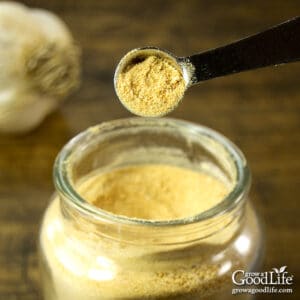
Homemade Garlic Powder
Ingredients
- 6 heads garlic
Instructions
- Separate the cloves of garlic from the head. Peel off the papery skins, and slice the cloves thin.
- To dry garlic using a dehydrator: Spread out the sliced garlic in a single layer on the dehydrator screens and dehydrate at 125˚F (52˚C) until the garlic is crispy and snaps when you break it, up to 12 hours. Rotate your screens several times to dry evenly.
- To dry garlic in an oven: Spread the sliced garlic on a parchment lined baking sheet and dry in a preheated, 150-200˚F (67-93˚C) oven for 1-2 hours until the garlic snaps when you break it.
- Let the dehydrated garlic cool, then grind into a powder using a high quality blender, spice grinder, or coffee grinder. Sift the powder to remove large pieces, and store the garlic powder in an airtight container in a dark, cool, and dry location.
- 6 large heads of garlic will make about 1/2 cup of garlic powder. Substitute 1/8 teaspoon of garlic powder for each clove called for in recipes.
Nutrition
You May Also Like:
Good planning is key to a successful vegetable garden
Whether you are new to growing your own food or have been growing a vegetable garden for years, you will benefit from some planning each year. You will find everything you need to organize and plan your vegetable garden in my PDF eBook, Grow a Good Life Guide to Planning Your Vegetable Garden.


I can’t believe I never thought to do this! I do it for ginger. I have a dehydrator and a coffee grinder just for herbs and spices. Thank you for the link to a garlic slicer! The only thing I would do differently is to remove the root from the garlic, as it can be bitter tasting. Or just buy fresh young garlic which has no visible root. The root is there but it hasn’t started to regrow like in your photo. I grow garlic but you’re right that when it gets old and soft it’s too late to use or dry. Salvaging it just before by drying it is fantastic 😍
The only thing I was looking for was not included in the directions. I was looking for the correct temperature to set the dehydrator at. The instructions say to dry on low heat. That’s the only possible option since dehydrators range from 90° to 135°. There is no high heat. Usually the temperature is listed but not in this one
Lisa, The dehydrating temperature is right in the recipe under instructions step 2: To dry garlic using a dehydrator.
Thank You FOR Sharing👍🏼♥️ GREAT INFORMATION!!
And Thanks For mentioning About If GARLIC gets Brown It WILL be BITTER 👎🏼I DO know from cooking You CANT OVERHEAT it Or It TASTES Bitter 👎🏼👎🏼👎🏼 I Make Garlic Spaghetti AND The Onions HAVE to BE clear Almost Before I Put The GARLIC in PAN. G-d♥️Bless
Thank you so much..I will definitely make my own garlic powder.
Such a great idea! I never attempted to make my own garlic powder and I didn’t realize that it’s this easy! Definitely something I need to try out.
What a great idea, I go through so much garlic but have never thought to turn it into a powder
I never thought to make my own garlic powder! How smart
Thanks for your well-written article on making our own garlic powder. I’m also interested in putting a good bit into gelatin capsules to use as a regular for health. The history on garlic and history back to Abraham, Egypt, Greece, and Rome is outstanding. I’m 84 (born 1934). After WW2 I heard several American soldiers tell of the Russian soldiers carrying bags of garlic with them. Our soldiers called it: Russian Penicillin. Apparently, it goes beyond the level of fiction. It has a reputation for helping clear blood vessels and being good to prevent cardiovascular problems. Its main contribution to health may be in keeping infected people away from our garlic breath.
Hey, this is a great recipe, but I just wonder if it is possible to dry the garlic under the sun. Will the taste remain the same? Thanks
Ratih, I am not sure. I have never tried it because the sun isn’t very warm where I am located. I bet it would work for warmer climates though.
I never thought about making my own garlic powder! Thank you for the idea.